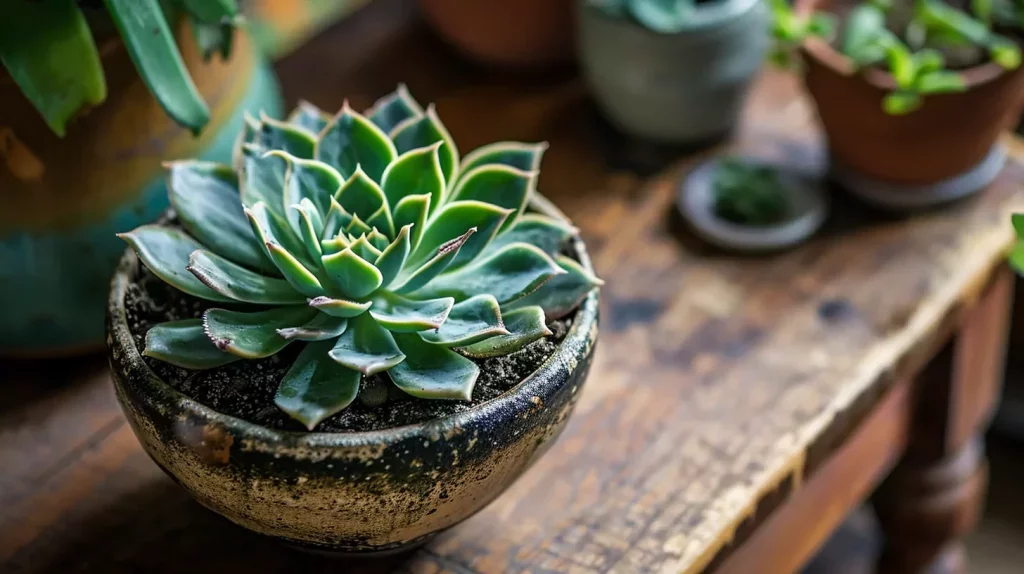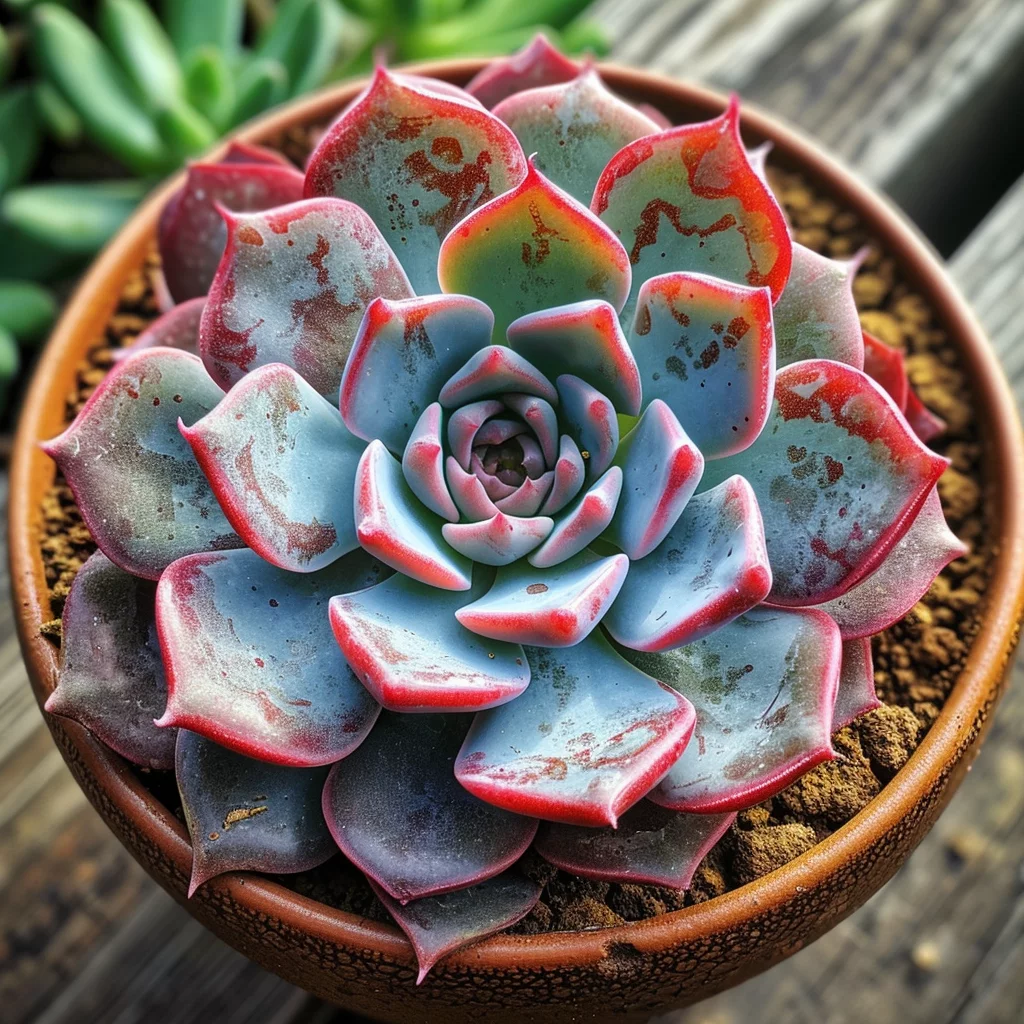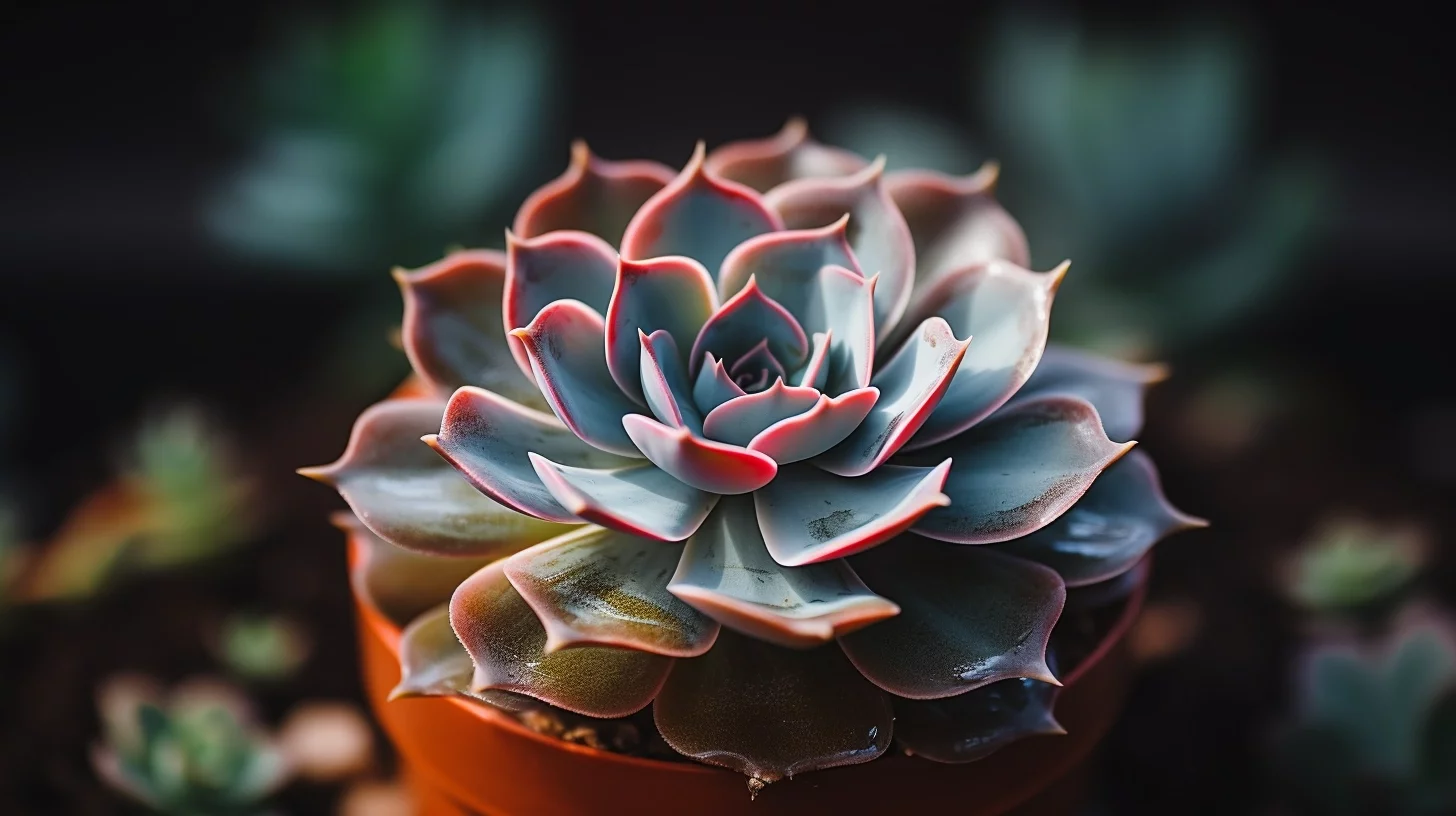Echeveria, a genus in the Crassulaceae family, is a group of succulent plants that have captured the hearts of gardeners and plant enthusiasts worldwide. Known for their stunning rosette shape, vibrant colors, and low-maintenance nature, Echeveria varieties add a touch of sculptural beauty to any setting.
Echeveria Succulents Overview
Echeveria succulents, often hailed as the crown jewels of the succulent world, boast a unique aesthetic appeal coupled with an easygoing nature. These plants are characterized by their distinctive rosette shape, formed by plump, fleshy leaves that come in a kaleidoscope of colors and textures.
Fast-Growing and Visually Striking
Echeverias are not only fast-growing but also boast an array of appearances, ranging from dusty greens and soft blues to vivid pinks and purples. Their leaves may be smooth, fuzzy, or even have fine hairs, adding to their tactile appeal. During certain times of the year, they produce bell-shaped flowers on tall stalks, adding an extra layer of beauty to their already charming structure.
A Native of The Americas
Hailing from the semi-desert regions of Central America, South America, and Mexico, Echeveria plants are accustomed to dry, rocky environments. This origin story is crucial in understanding their care needs, particularly their preference for bright light and well-draining soil. Thriving in a Mediterranean climate, they embody the perfect blend of ornamental beauty and drought-tolerant hardiness.
Adaptable and Resilient
One of the key reasons Echeverias are beloved by beginners and experienced gardeners alike is their adaptability. They can thrive both indoors and outdoors, provided they receive adequate sunlight and are shielded from harsh winter conditions. Their resilience and ability to thrive with minimal care make them an ideal choice for those looking to add a succulent touch to their plant collection.
| Feature | Echeveria Info |
|---|---|
| Family | Crassulaceae |
| Native Region | Central America, Mexico |
| Growth Habit | Rosette-forming |
| Sun Exposure | Full sun to partial shade |
| Watering Needs | Low (drought-tolerant) |
| Soil Preference | Well-draining, sandy soil |
| Bloom Time | Spring to Summer |
| Flower Color | Red, pink, orange, or yellow |
| Propagation | Leaf cuttings, offsets |
| Common Varieties | E. ‘Black Prince’, E. ‘Perle von Nürnberg’, E. ‘Blue Prince’ |

Types of Echeveria
Diversity is the spice of life, and the Echeveria genus is a testament to this adage. With over a hundred recognized species and numerous hybrids, there’s an Echeveria out there for every succulent enthusiast.
Echeveria ‘Ghost’
The Ghost Echeveria, or Echeveria lilacina, is a popular variety known for its pale, silvery-grey leaves. It thrives in full to partial sunlight and requires minimal watering, making it a perfect addition to rock gardens or desert landscaping.
Echeveria Peacockii
Echeveria Peacockii, or Peacock Echeveria, is distinguished by its blue-green leaves and a slight pink tint on the leaf tips. This type prefers well-draining soil and can tolerate more watering than some of its counterparts, as long as it’s allowed to dry between waterings.
Echeveria ‘Mexican Snowball’
Mexican Snowballs, or Echeveria elegans, are characterized by their spherical rosettes of spoon-shaped, pale green leaves. They are especially hardy and can tolerate colder temperatures better than most Echeveria species.
Echeveria ‘Mexican Firecracker’
This variety, known for its fiery red-tipped leaves, adds a burst of color to any succulent garden or arrangement. The Mexican Firecracker requires ample sunlight to maintain its vibrant colors and prefers less frequent watering.
Echeveria agavoides ‘Lipstick’
Echeveria ‘Lipstick’ is a striking variety with bright red edges, resembling a lipstick outline. This particular species is known for its pointed, slightly more rigid leaves compared to the softer, more pliable leaves of other Echeverias.
Each type of Echeveria brings its unique charm and characteristics, making it a diverse and fascinating group to collect and care for. Understanding the specific needs and preferences of each variety is key to ensuring they flourish and bring their full beauty to your garden or home.
Care: Creating the Ideal Environment for Echeveria
Echeverias, known for their drought tolerance and easy-care nature, still require specific conditions to thrive. Understanding these needs is crucial for healthy growth.
Light Requirements: Sun Lovers at Heart
Echeverias adore sunlight. They thrive in environments where they can bask in plenty of bright, indirect light. When grown indoors, place them near a south-facing window to ensure they receive enough light. If you notice your Echeveria stretching out or becoming leggy, this is a sign it’s not getting enough light.
- Outdoor Growing: In outdoor settings, Echeverias can handle more direct sunlight, especially in the morning. However, in extremely hot climates, afternoon shade is beneficial to prevent sunburn.
- Artificial Lighting: For those growing Echeverias in less sunny climates, artificial grow lights can supplement the lack of natural sunlight.
Watering: Less is More
The watering needs of Echeveria are minimal. These succulents prefer a “soak and dry” method. Allow the soil to completely dry out between waterings, then water deeply until it runs out of the drainage holes. Overwatering can lead to root rot, a common issue in succulents.
- Monitoring Moisture: Use your finger or a moisture meter to check the soil moisture. Water only when the soil is dry to the touch.
- Seasonal Adjustments: Reduce watering in the winter when the plant is dormant.
Soil and Potting Mix
Well-draining soil is essential for Echeveria. A standard cactus or succulent potting mix is ideal. You can also make your own mix by combining potting soil with sand or perlite to increase drainage.
- Choosing the Right Container: Make sure your pot has drainage holes. Terracotta pots are an excellent choice as they allow the soil to dry out more quickly than plastic or glazed pots.
Pruning: Keeping Your Echeveria Tidy and Healthy
Pruning is an important aspect of Echeveria care. It not only keeps the plant looking tidy but also encourages healthier growth.
When to Prune
The best time to prune Echeveria is in the spring or early summer, at the beginning of its active growth period. This is when the plant can recover and grow back more vigorously.
How to Prune
Use clean, sharp scissors or pruning shears. Remove any dead or dying leaves from the bottom of the plant. This helps prevent pest infestations and fungal diseases. You can also trim back any leggy growth to maintain the plant’s rosette shape.
- Pruning for Size: If your Echeveria is getting too big for its pot or you want to maintain a certain size, you can prune back the top growth. Just be sure not to remove more than one-third of the plant at a time.
Propagating: Multiplying Your Echeveria Collection
Echeverias are easily propagated, offering a simple and satisfying way to expand your collection. The most common methods are leaf propagation and offsets.
Leaf Propagation
Gently twist a leaf from the stem, ensuring it comes off cleanly without tearing. Let the leaf dry for a few days to form a callus over the cut surface. Then, place it on top of a well-draining soil mix and mist lightly. Roots and a new rosette will eventually form.
- Patience is Key: Leaf propagation can be a slow process, so patience is essential. Ensure the propagating leaves get plenty of indirect light and minimal but consistent moisture.
Propagating from Offsets
Echeverias often produce offsets, or “pups,” which can be separated from the parent plant. Gently remove the offset, ensuring it has some roots attached, and plant it in its own pot with well-draining soil.
- Encouraging Offsets: To encourage your Echeveria to produce offsets, ensure it is in a slightly snug pot and receiving appropriate care.
In summary, Echeveria care involves a balance of proper light, water, soil, and occasional pruning and propagation. Whether you’re a seasoned succulent gardener or a beginner, understanding these key aspects will help you grow and maintain vibrant, healthy Echeveria plants. With their array of colors, shapes, and sizes, Echeverias are sure to bring joy and a touch of nature’s artistry to your space.
Potting and Repotting Echeverias
Potting and repotting are crucial aspects of Echeveria care. While these plants are not high-maintenance, understanding the nuances of potting can significantly impact their health and growth.
When to Repot Echeverias
Echeverias generally don’t require frequent repotting. It’s recommended to repot these succulents in spring if they have outgrown their container or the soil has degraded. Spring repotting aligns with their active growing period, facilitating better root establishment in the new pot.
Choosing the Right Pot and Soil
Select a pot that is slightly larger than the current one, ensuring it has adequate drainage holes. Echeverias thrive in well-draining cactus or succulent potting mix. You can enhance drainage by adding perlite or coarse sand to the mix.
Careful Handling During Repotting
Gently remove the Echeveria from its current pot, shaking off excess soil and inspecting the roots. Trim any dead or rotting roots to promote healthy growth. Allow the roots to dry for a day or two before placing the plant in its new pot. This helps prevent root rot, a common issue in succulents.
After Repotting
Once repotted, avoid watering the plant immediately. Let it settle for about a week before resuming a regular watering schedule. This period allows the plant to recover and reduces the risk of root rot.
Overwintering Echeveria
Echeverias, with their preference for warm climates, need special care during the colder months. Overwintering these plants properly ensures their survival and continued growth.
Bringing Echeverias Indoors
Echeveria plants cannot withstand freezing temperatures and should be brought indoors during winter. Place them in a location that receives bright, indirect sunlight, such as a south-facing window.
Watering During Dormant Months
During cooler months, Echeveria plants enter a dormant state. Reduce watering significantly during this period. The soil should be allowed to dry out completely between waterings. Overwatering during dormancy can lead to root rot and other issues.
Temperature Considerations
Maintain a consistent temperature above freezing point, ideally between 50-60°F (10-15°C). Avoid placing your Echeveria near cold drafts or heating vents, as fluctuations in temperature can stress the plant.
Common Pests and Diseases
Echeverias, like all plants, are susceptible to pests and diseases. Recognizing and addressing these issues early is key to maintaining healthy plants.
Dealing with Pests
Common pests that affect Echeveria include mealybugs, spider mites, and fungus gnats. These can be managed using insecticidal soap or neem oil. Regular inspection of your plants can help catch infestations early.
Fungal Issues
In cold or damp conditions, Echeverias may develop fungal problems. Signs include soft, mushy spots on leaves or stems. To treat fungal issues, remove any affected parts, repot the plant in fresh, dry soil, and reduce watering. In severe cases, a fungicidal soil treatment may be necessary.
Preventative Care
Preventing pest infestations and diseases begins with proper care. Ensure your Echeverias are in well-draining soil, receive adequate light, and are not overwatered. Good air circulation around your plants also helps prevent many issues.
Growing Echeveria from Seed
Starting Echeveria from seed can be a gratifying process for any plant enthusiast. It requires patience, precision, and a bit of know-how.
Seed Sowing Basics
To embark on this journey, you’ll need to start with a well-prepared bed of soil. The ideal mixture for Echeveria seeds combines potting soil, grit, sand, and perlite, ensuring excellent drainage and aeration.
- Mix Composition: A mix with equal parts of soil, grit, or sand, and perlite works best. This composition ensures the seeds have the right environment for germination and initial growth.
- Sowing Technique: Scatter the seeds lightly over the surface of your prepared mix. These seeds need light to germinate, so avoid covering them with additional soil.
Creating the Perfect Germination Environment
Your Echeveria seeds will need the right temperature and moisture level to sprout successfully.
- Temperature: The ideal germination temperature for Echeveria seeds is between 65 to 70 degrees Fahrenheit. This range encourages the seeds to sprout and grow.
- Watering Needs: Regular watering is essential, but remember, the key is consistency without overdoing it. The soil should be kept moist but not waterlogged. A spray bottle can be used to gently mist the soil, keeping it perfectly hydrated for sprouting seeds.
Patience is a Virtue
Remember, growing Echeverias from seed is a slow process. It requires patience as you wait for those tiny seeds to sprout and grow into beautiful rosette formations.
How to Get Echeveria to Bloom
Echeveria plants are known for their stunning blooms, which can be encouraged with the right care and conditions.
Understanding the Blooming Cycle
Echeverias typically take at least four seasons to mature enough to produce flowers. This growth period is essential as it allows the plant to develop the strength needed to support its blooms.
- Patience for Blooming: It’s important to understand that Echeverias won’t bloom immediately. They need time to grow and mature.
Encouraging Flowers
There are a few tricks to help your Echeveria bloom:
- Deadheading: Remove spent blooms to encourage new ones. This process directs the plant’s energy towards producing more flowers.
- Fertilization: Use a high-phosphorus fertilizer to stimulate blooming. This specific nutrient mix supports the development of healthy and vibrant flowers.
- Sunlight and Soil: Adequate sunlight and well-draining soil are crucial. Echeverias need plenty of light to bloom, ideally in a south- or west-facing window.
Blooming Conditions
Ensure your plant gets enough sunlight and is planted in well-draining soil. These conditions mimic the natural environment where Echeverias thrive and bloom.
Common Issues with Echeveria
While Echeverias are relatively easy to care for, they can encounter a few common problems, especially when their care needs are not met.
Overwatering and Underwatering
One of the biggest challenges with Echeverias is getting the watering right.
- Overwatering: Signs include discoloration and a mushy texture. Overwatering can lead to root rot, which is detrimental to the plant.
- Underwatering: Symptoms include wilting, limpness, and shriveled leaves. While Echeverias are drought-tolerant, they still need regular watering.
Fungal Infections
Stem rot, indicated by yellowing, mushy stems, can occur in Echeverias, usually due to excess moisture.
- Prevention and Treatment: Ensure your plant is not sitting in soggy soil and has proper air circulation. If stem rot occurs, you may need to repot the plant and treat the soil with a fungicide.
Longevity and Sunlight
Echeverias can live anywhere from three years to several decades. Their lifespan greatly depends on their growing conditions, particularly sunlight exposure. A south- or west-facing window is ideal for maximum light.
Echeveria, with its delightful rosettes and minimal care requirements, makes for a splendid addition to any collection. Whether you’re starting from seeds or nurturing a mature plant, these succulents bring a touch of arid elegance to your home or garden. And for those looking to diversify their succulent array, Haworthia and Sempervivum offer similar delights. 🌵🌞💦

Echeveria Plant FAQ: Everything You Need to Know 🌿🌸
1. What Are the Different Varieties of Echeveria?
Echeveria is a large genus with a variety of types, each boasting unique characteristics. From the classic ‘Hen and Chicks’ to the powdery or waxy leaves of certain cultivars, there’s an Echeveria to suit every taste. The diversity is evident in our photo gallery, showcasing species and cultivars with leaves ranging from deep greens to ones with red tips.
2. How Do I Care for My Succulent Plant?
Care instructions for Echeveria are relatively straightforward. These succulents need to be kept in well-draining soil that has dried out completely between waterings. They thrive in bright light, so placing them near a sunny window is ideal. Regularly remove dead leaves from the lower part of the plant to encourage new growth and prevent mealy bugs.
3. When and How Should I Fertilize My Echeveria?
Fertilize your Echeveria in spring or summer when the plants are actively growing. Use a slightly acidic fertilizer and increase the amount gradually to avoid over-fertilizing, which can harm the plant. This will promote healthy foliage and flower buds.
4. Can Echeveria Plants Survive Frost?
Echeverias, being accustomed to growing in warmer climates, cannot withstand frost. Protect your plants from freezing temperatures by bringing them indoors during the colder months. If grown in garden beds, consider using frost covers to shield them.
5. What Should I Do If My Plant Doesn’t Bloom?
While Echeveria is an evergreen plant known for its stunning foliage, it can also produce beautiful flowers with yellow tips on tall flower stalks. If your plant isn’t blooming, ensure it’s getting enough light to thrive. Sometimes, a bit of neglect can encourage Echeveria to flower, as stress can stimulate blooming.
6. How Can I Propagate Echeveria?
Propagating Echeveria is relatively simple and can be done through leaf cuttings. Gently twist a leaf from the stem and lay it on fresh soil, letting it dry for a few days. Once the leaf develops roots and a new plant, transfer it to a pot with well-draining soil.
7. How to Manage Pests Like Mealy Bugs?
Mealybugs can be a common issue, particularly in the crevices between leaves and stems. Treat infestations with a mixture of water and mild soap, or use insecticidal sprays specifically designed for succulents. Regularly inspect your plant and remove any affected leaves.
8. Can I Plant Echeveria Outdoors?
Echeverias enjoy growing in sunny spots in the garden. They are ideal for rock gardens or as part of a succulent collection in garden beds. Just ensure the soil is completely dry between waterings and the plants receive the right amount of light.
9. What Are Some Common Problems with Succulent?
Issues such as over- or underwatering can cause the leaves to discolor or the flower stems to wilt. Ensure the soil is completely dry before watering again. During periods of neglect, it’s important to water the plant thoroughly to revive it.
Megan Stewart, a houseplant aficionado and biologist, resides in the city of Portland, Oregon, USA. Her passion for greenery is matched only by her academic prowess; Megan holds a degree in Biology from the University of Oregon. This background has provided her with a rich understanding of the biological intricacies of plant life, which she skillfully applies to her collection of indoor plants.
Megan's home is a testament to her love for all things green, filled with a diverse array of houseplants ranging from exotic orchids to robust succulents. When she's not tending to her indoor garden, she spends her time with her beloved pets, a constant source of companionship and joy. Her articles are a reflection of her life's passions, offering readers a blend of practical plant care advice, and insightful biological tidbits.
Through her writing, Megan aims to inspire others in the USA and beyond to create their urban jungles and foster a deeper connection with nature.


